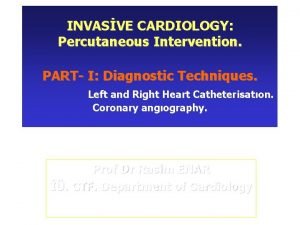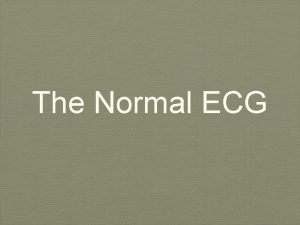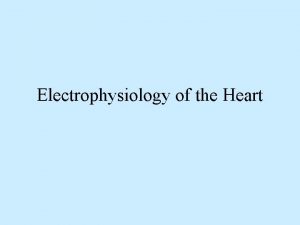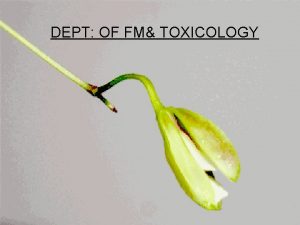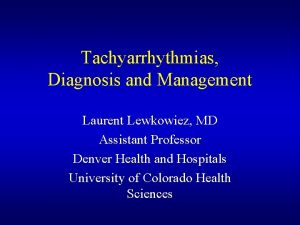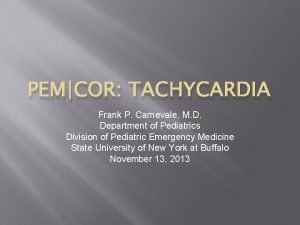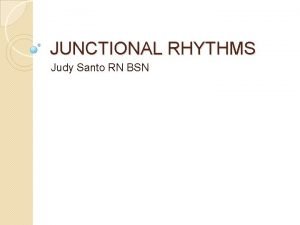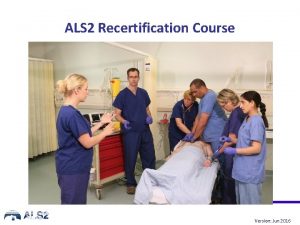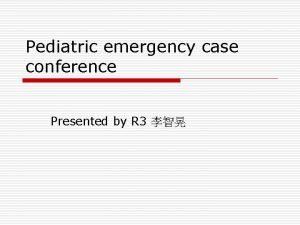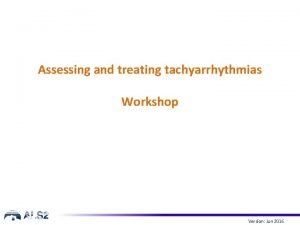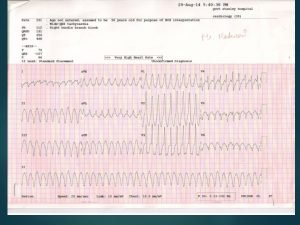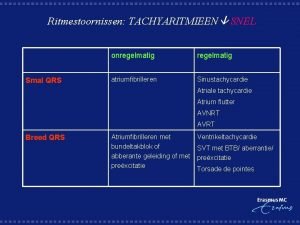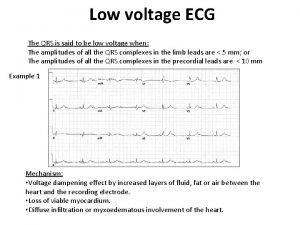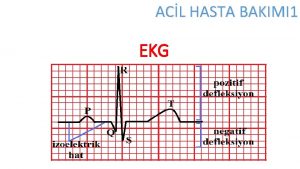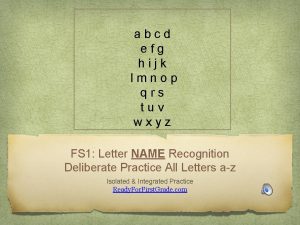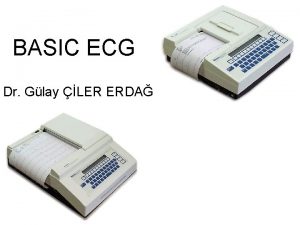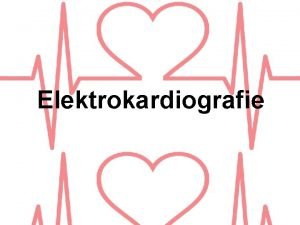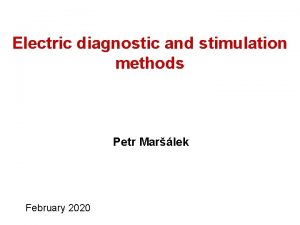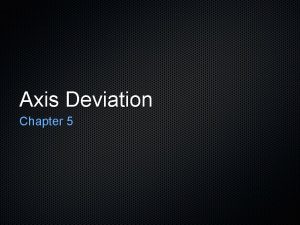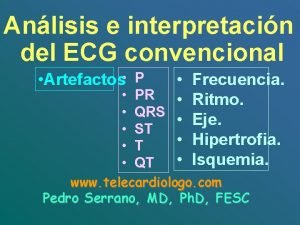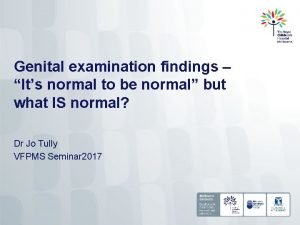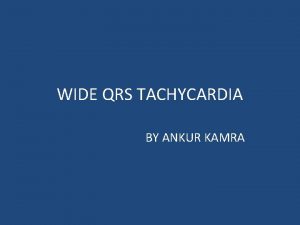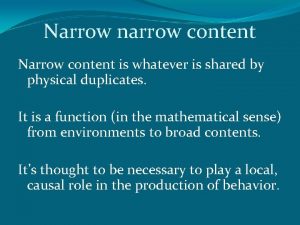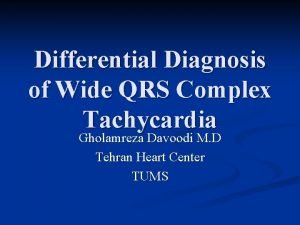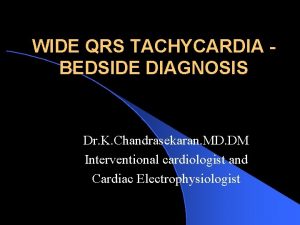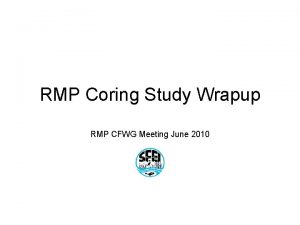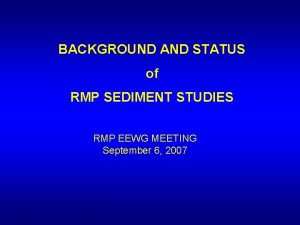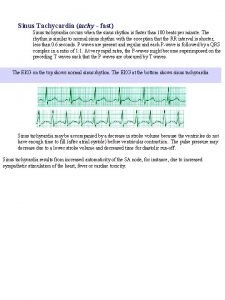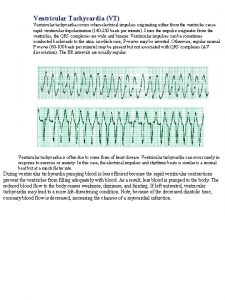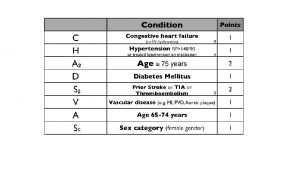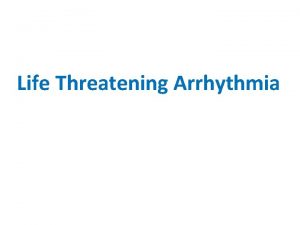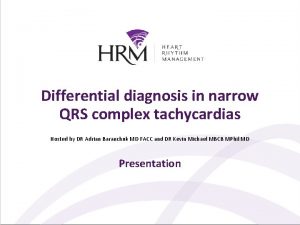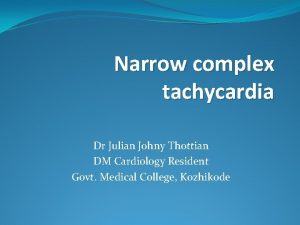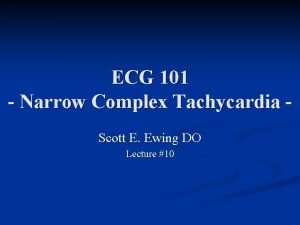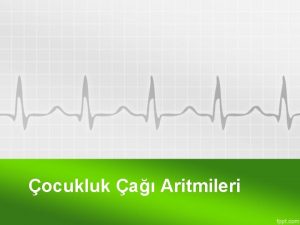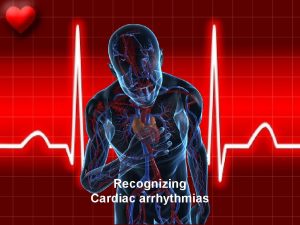Approach to narrow QRS tachycardia The normal RMP

































































- Slides: 65

Approach to narrow QRS tachycardia

Ø The normal RMP in myocardium is -90 mv Ø SA node differs from myocardium by Ø RMP is -65 mv Ø low overshoot Ø short duration Ø The phase 1 repolarisation corresponds to isoelectric ST segment of ECG


RELATIONSHIP OF INTRACELLULAR POTENTIAL TO SURFACE EKG

RELATIONSHIP OF INTRACELLULAR POTENTIAL TO SURFACE EKG SN P VP ARP RRP

RELATIONSHIP OF INTRACELLULAR POTENTIAL TO SURFACE EKG

Properties resposible for any arrythmia is abnormal automaticity conductivity refractoriness

Mechanism of Tachyarrhythmia Abnormal impulse formation Automaticity Enhanced Abnormal impulse conduction Reentry Triggered EADs DADs Anisotropy Anatomic F

CLINICAL EVALUATION • • • History Palpitations - Greater than 96% Dizziness - 75% Shortness of breath - 47% Syncope - 20% Chest pain - 35% Fatigue - 23% Diaphoresis - 17% Nausea - 13%

• CLINICAL CLUES FROM • PULSE • JVP • HEART SOUNDS

• Diagnosis of arrythmias is made by • rate and regularity of P wave, P-P interval • relationship of P and QRS • configuration of P and QRS

If the P wave is not found modifications LEWIS lead RA to Rt 2 nd ICS LA to Rt 4 th ICS Esophageal lead Intracardiac lead

LADDERGRAM OR LADDER DIAGRAM • Depicting temporal relationship between atrial and ventricular repolarisation • Timing correlates with ecg in horizontal direction • A---- Pwave duration • A-V ------P-R segment • V------QRS duration



Approching ECG





Atrial flutter features • Rapid , regular atrial rhythm at a rate of 200 -400/min • Waves are regular , uniform amplitude in morphology and amplitude. No iso electric segment in between • Usually 2: 1 or 4: 1 conduction to ventricle • Wenkebach type conduction can occur • 1: 1 conductive response suggests Accesery pathway Class 1 A, 1 C drugs slowing rate of AFL (Hence Class IA and IC drugs should be administered in conjunction with an AV nodal blocking agent (beta blocker or calcium channel blocker) of Catecholamine excess like exercise, excitement, induction Anesthesia IV atropine

• Usually transient • Associated with underlying structural heart disease • Digoxin convert AFL to AF • Sodium blocking drugs convert AF to AFL then to sinus rhythm • Markedly enlarged atria tend to have slow rate • Ectopic atrial tachycardia and AFL seldom coexist in same pt

Mechanisms • A large or small re entrant loop • Single or multiple focus of automaticity • “Isthmus of slow conduction” It is in postero septal part of rt atrium betwn orifices of IVC, coronary sinus , tricuspid annulus ring – It is the promising target for ablation to interrupt AFL : Ablation is commonly performed at the 6: 00 position on the tricuspid valve isthmus

Types of atrial flutter Type 1 (common/typical) rate 240 -350/mt can be entraine d byatrial pacing subdivided into counterclock wise (cephalad)(Most common) inverted in Lead 2, 3, a. VF positive in V 1 clockwise (cranial to caudal) positive in Lead 2, 3, a. VF either positive or negative in V 1 Type 2 (less common) rate 340 -430 cant be entrained by pacing

Type I Atrial Flutter • Typical atrial flutter, or "isthmus-dependent" flutter, is a macroreentrant arrhythmia that involves a long slow path with an excitable gap, forming a circuit within the right atrium. • Slowly conducting reentrant circuit is located in the low right atrial isthmus. • The isthmus of tissue is between the inferior vena cava and tricuspid annulus.

Type I

Type I

Type II Atrial Flutter • Atypical atrial flutter lacks an excitable gap and is not isthmus-dependent. • Usually this rhythm results from an intra-atrial reentrant circuit that is very short. • May be due abnormal anatomy within the right or left atrium (i. e. surgical scars, irregular pulmonary veins, disturbed mitral annulus)

Diagnosis: EKG • EKG will typically show 2: 1 conduction across the AV node (even ratios of conduction are more common than odd ratios) – May need to administer adenosine to slow conduction through AV node







Typical Atrioventricular Nodal Reentry tachycardia ( AVNRT(















Electrophysiology study







CLASSIFICATION OF AVNRTS AH/HA VA(Hs) ERAA Typical AVNRT(slow – fast) ˃1 ˂60 ms RHs, CS os, LHs Atypical AVNRT(fastslow) ˂1 ˃60 ms CS os, LRAS, d. CS Atypical AVNRT ˃1 (slow-slow) ˃60 ms CS os, d. CS VA indicates interval measured from the onset of ventricular activation on surface ECG to the earliest deflection of the atrial activation in the His bundle electrogram; ERAA, earliest retrograde atrial activation; RHis, His bundle electrogram recorded from the right septum; LHis, His bundle electrogram recorded from the left septum; LRAS, low right atrial septum; CS os, ostium of the coronary sinus; and d. CS, distal coronary sinus. *Variable earliest retrograde atrial activation has been described for all types of AVNRT







 Narrow qrs complex
Narrow qrs complex Narrow qrs complex
Narrow qrs complex Normal p wave
Normal p wave Sinus rhythm with couplets
Sinus rhythm with couplets Caras del corazon con derivaciones
Caras del corazon con derivaciones Vm membrane potential
Vm membrane potential Amway vs rmp
Amway vs rmp Psm vs rmp
Psm vs rmp Duties of rmp
Duties of rmp Smooth muscle rmp
Smooth muscle rmp Orthodromic reciprocating tachycardia
Orthodromic reciprocating tachycardia Pals hypovolemic shock algorithm
Pals hypovolemic shock algorithm Judy santo
Judy santo Jessica schwenk
Jessica schwenk Pulseless vf
Pulseless vf Als2 bradycardia algorithm
Als2 bradycardia algorithm Tachycardia treatment
Tachycardia treatment Sinus brady with pjc
Sinus brady with pjc Als2 tachycardia algorithm
Als2 tachycardia algorithm Vereckei algorithm
Vereckei algorithm Aberrantie ecg
Aberrantie ecg Ecg low voltage
Ecg low voltage Ventriküler fibrilasyon nedir
Ventriküler fibrilasyon nedir Abcdefghi lmnopqrstuvwxyz
Abcdefghi lmnopqrstuvwxyz Smalle qrs-komplekser
Smalle qrs-komplekser Qrs komplex
Qrs komplex Qrs complex duration
Qrs complex duration Normaali sydänkäyrä
Normaali sydänkäyrä Qrs axis calculator
Qrs axis calculator Hemibloqueo anterior izquierdo
Hemibloqueo anterior izquierdo It's normal to be normal
It's normal to be normal Difference between virtual circuit and datagram
Difference between virtual circuit and datagram Cognitive approach vs behavioral approach
Cognitive approach vs behavioral approach International market selection model
International market selection model Multiple approach-avoidance
Multiple approach-avoidance Cognitive approach vs behavioral approach
Cognitive approach vs behavioral approach Study approach meaning
Study approach meaning Traditional development approach
Traditional development approach Tony wagner's seven survival skills
Tony wagner's seven survival skills Hát kết hợp bộ gõ cơ thể
Hát kết hợp bộ gõ cơ thể Ng-html
Ng-html Bổ thể
Bổ thể Tỉ lệ cơ thể trẻ em
Tỉ lệ cơ thể trẻ em Gấu đi như thế nào
Gấu đi như thế nào Thang điểm glasgow
Thang điểm glasgow Hát lên người ơi alleluia
Hát lên người ơi alleluia Các môn thể thao bắt đầu bằng từ đua
Các môn thể thao bắt đầu bằng từ đua Thế nào là hệ số cao nhất
Thế nào là hệ số cao nhất Các châu lục và đại dương trên thế giới
Các châu lục và đại dương trên thế giới Cong thức tính động năng
Cong thức tính động năng Trời xanh đây là của chúng ta thể thơ
Trời xanh đây là của chúng ta thể thơ Cách giải mật thư tọa độ
Cách giải mật thư tọa độ 101012 bằng
101012 bằng độ dài liên kết
độ dài liên kết Các châu lục và đại dương trên thế giới
Các châu lục và đại dương trên thế giới Thể thơ truyền thống
Thể thơ truyền thống Quá trình desamine hóa có thể tạo ra
Quá trình desamine hóa có thể tạo ra Một số thể thơ truyền thống
Một số thể thơ truyền thống Bàn tay mà dây bẩn
Bàn tay mà dây bẩn Vẽ hình chiếu vuông góc của vật thể sau
Vẽ hình chiếu vuông góc của vật thể sau Biện pháp chống mỏi cơ
Biện pháp chống mỏi cơ đặc điểm cơ thể của người tối cổ
đặc điểm cơ thể của người tối cổ Thế nào là giọng cùng tên
Thế nào là giọng cùng tên Vẽ hình chiếu đứng bằng cạnh của vật thể
Vẽ hình chiếu đứng bằng cạnh của vật thể Tia chieu sa te
Tia chieu sa te Thẻ vin
Thẻ vin
